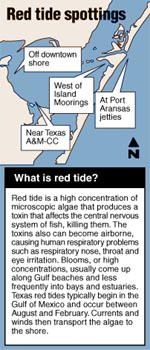Disclaimer: These postings were sent to us from a variety of media sources over the Internet. The content has not been reviewed for scientific accuracy or edited in any manner.
Large bloom of red tide reported by state officials
Monday, September 25, 2000
Toxic algae detected in two local bays and near the Port A jetties
By Venessa Santos Caller-Times
 State agencies are closely monitoring what at least one state
official said is the largest concentration of red tide in the Gulf of
Mexico since 1986 when a strain passed through the area, killing more
than 22 million fish in a four-month period.
State agencies are closely monitoring what at least one state
official said is the largest concentration of red tide in the Gulf of
Mexico since 1986 when a strain passed through the area, killing more
than 22 million fish in a four-month period.
Dave Buzan, spokesman for the Texas Department of Parks and Wildlife Kills and Spills Team, said that locally, the algae have reached high enough concentrations to be seen by the naked eye and cause respiratory irritation in humans.
The current outbreak already has resulted in millions of dead fish, he said.
"We do not have an accurate number yet," said Buzan. "But we are estimating several million fish have been killed so far."
According to the Texas Parks and Wildlife daily Internet update, biologists observed red tide on Sunday in the Corpus Christi Bay near the downtown area. They also observed red tide in the Oso Bay and near the Port Aransas jetties. Since Labor Day weekend, streaks of the algae also were spotted in the Gulf of Mexico near Galveston and in the west end of Matagorda Bay.
Buzan said one visible bloom off Matagorda Bay appeared on Sept. 18 and now spans more than a 70-square-foot area.
"It is so big it can be detected on satellite imagery," Buzan said.
Red tide is a high concentration of microscopic algae that produces a toxin, which affects the central nervous system of fish and kills them. While the fish kills usually consist of schooling species, such as mullet and menhaden, the algae has a domino effect on other marine life.
"Some (fish) do not die from red tide," said Wes Tunnell, director of the Center for Coastal Studies at Texas A&M University-Corpus Christi. "They die from lack of oxygen."
Blooms, or high concentrations, usually come up along Gulf beaches and less frequently into bays and estuaries. They can become so dense that the water turns a reddish-brown and causes the oxygen levels in the water to drop far below normal. Usually, smaller fish die off first, but larger fish suffer as their food supply dwindles, Tunnell said.
The toxins also can become airborne, causing human respiratory problems such as respiratory nose, throat and eye irritation.
Red tides near the Texas coast typically begin in the Gulf of Mexico and locally occur between August and November, Buzan said. Currents and winds then transport the algae to the shore.
The Department of Health also warns that people can get neurotoxin shellfish poisoning from eating clams, mussels, whelks and oysters contaminated by red tide.
The department warns the public against harvesting for personal consumption. Red tide poison symptoms include nausea and dizziness that can last for several days. Seafood such as crab, shrimp and fish should be safe from contamination.
In Galveston Bay, commercial harvesting of oysters has been shut down since Sept. 5 because of red tide. The Texas Department of Health's Seafood Safety Division officials are monitoring the situation locally to see if similar restrictions will need to be issued in the Coastal Bend. Oyster season doesn't open in Corpus Christi until November.
"We will be looking to determine if it is safe to open for oyster season," said Kirk Wiles, director of Seafood Safety. "We will have to see if there are any problems at that time."
Terry Colson, manager of the Two George's World Famous seafood restaurant, said harvesting restrictions would definitely have an effect on his business.
"I go through about 40 to 50 gallons of oysters a week," said Colson. "It would cost me between $2 to $4 more a gallon to bring them in from somewhere else."
Colson, who has experienced the effects of red tide in past years, said outbreaks don't normally last long enough to affect his customers because the restaurant shoulders the higher prices. It would take at least three months before his patrons would see a price increase in oysters.
"We just try and eat it for a while."
For more information on red tide, visit the Texas Parks and Wildlife Web site at www.tpwd.state.tx.us. or by calling (800) 792-1112.
Staff writer Venessa Santos can be reached at 886-3752 or by e-mail at santosv@caller.com